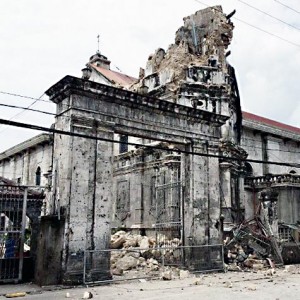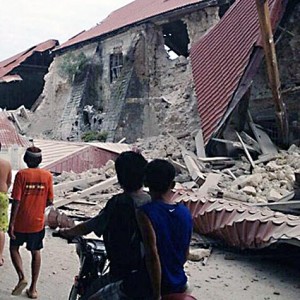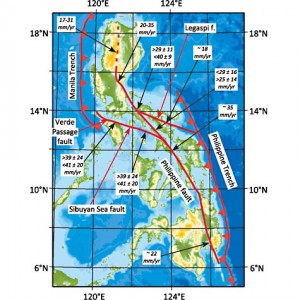

 NOONG A-KINSE ng Oktubre, ang Bohol, Cebu at iba pang karatig pook nito ay niyanig ng 7.2 magnitude na lindol. Marami ang nasirang istraktura, nasalantang mga ari-arian at namatay. Hindi rin pinaligtas ang mga luma at historical churches na karaniwan ay yari sa limestones at puti ng itlog. Ito ay mga hindi ginagamitan ng bakal, isang patunay na antigong pamamaraan ng inhinyerong ito ay matibay bagama’t kamakailan nga ay nasira ng mapaminsalang lindol.
NOONG A-KINSE ng Oktubre, ang Bohol, Cebu at iba pang karatig pook nito ay niyanig ng 7.2 magnitude na lindol. Marami ang nasirang istraktura, nasalantang mga ari-arian at namatay. Hindi rin pinaligtas ang mga luma at historical churches na karaniwan ay yari sa limestones at puti ng itlog. Ito ay mga hindi ginagamitan ng bakal, isang patunay na antigong pamamaraan ng inhinyerong ito ay matibay bagama’t kamakailan nga ay nasira ng mapaminsalang lindol.
ISIPIN ANG KALIGTASAN
DAPAT MAGING alerto ang isip, huwag mag-panic, unahin ang ating kaligtasan. Kinakailangang tumakbo palabas ng bahay o gusali at makarating sa malayo nang ‘di mabagsakan ng anumang paguho at doon ay paupong ipatong ang dalawang kamay sa ulo. Magmasid habang nagaganap ito. Makatutulong ang mga dalangin upang kumalma ang isip at maging alerto.
Kung malapit sa dagat, maaaring tumakbo palapit sa matataas na lugar tulad ng bundok upang makaiwas sa kung sakaling may warning ng tsunami. Kung inabutan sa loob ng opisina, ng bahay o malaking building, dapat na maghanap ng makakanlungan katulad ng mesa. Pumasok sa ilalim nito at hawakan ang dalawang kamay ng mesa. Iwasan ang mga tulay at maging ang mga sasakyan ay huwag nang patakbuhin. Ang mga ganitong disaster ay ipalagay na nating bahagi na ito ng paggalaw ng lupa, lalo na tayo ay prone sa mga ganitong pangyayari. Ang ating bansa ay bahagi ng sinasabing Ring of Fire.
CASUALTIES
ITINATALA SA kasalukuyan ang bilang ng mga namatay ay 144, samatalang 23 ang nawawala at ilang daan din ang malubhang sugatan. Inestima namang 2 to 4 bilyong piso ang mga nasirang ari-arian.
ANG PHILIPPINE FAULT SYSTEM
THE PHILIPPINE Fault System is an inter-related system of faults throughout the whole of the Philippine Archipelago, primarily caused by tectonic forces compressing the Philippines into what tectonic geophysycist call the Philippine Mobile Belt.
The main fault runs most of the length of the Philippines and is called the Philippine Fault. It extends from Davao Gulf in the south, bisects CARAGA region at the Agusan River basin, crosses to Leyte and Masbate islands, and traverses Quezon province in eastern Luzon before passing through Nueva Ecija up to the Ilocos region in northwest Luzon. Here, the fault has become braided and is no longer single. The Philippine Fault, probably active since the Middle Miocene is a recent example of the north-south strike-slip fault zones of Luzon. The N150E segment, which breaks the meridian continuity of the Philippine Fault system in Luzon, is located to the west of Benham Plateau on the western edge of the Philippine Sea Plate. The N150E fault probably has a recent genesis and could be a mechanism to absorb backwards the convergence between Benham Plateau and the east Luzon arc.
The west segment, known as the Western Marikina Fault was one of the two fault segments of the Valley Fault System which runs through the cities of Marikina, Pasig and Muntinlupa and moves in a dominantly dextral strike-slip motion. The West Fault is capable of producing large scale earthquakes on its active phases with a magnitude of 7 or higher.
The Valley Fault System and formerly as the Marikina Valley Fault System is a group of dextral strike-slip fault which extends from San Mateo, Rizal to Taguig City on the south; running through the cities of Makati, Marikina, Paranaque, Pasig and Taguig. The fault possesses a threat of a large scale earthquake with a magnitude of 7 or higherwithin the Manila Metropolitan Area with death toll predicted to be as high as 35,000 and some 120,000 or higherinjuredand more than three million needed to be evacuated.
LIQUEFACTION (potential areas in Metro Manila)
RECLAIMED AREAS, Manila proper except the extreme north-northeast districts; Malabon; Navotas; western portion of Valenzuela; extreme northwestern part of Pasay, and Paranaque and Las Pinas; southwesten half of Caloocan City (south) lakeshore immediately adjacent to Laguna de Bay that include parts Muntinlupa and Taguig; Pateros; central Pasig; extreme western part of Marikina; and extreme eastern Quezon city.
Ito ang larawan a canvas ni Maesto Orobia.
*Soure: Wikipedia and Google Images
For comments and suggestions, e-mail: orobiakpp@yahoo.com
Larawan sa Canvas
By Maestro Orobia



















